By Élan Young
How often are we reminded that less is more, as if this maxim holds the secret to a happy life? While this might be true in some circumstances, for many amputees and people with limb difference, more might in fact be the order of the day, at least when it comes to mobility options. Mobility is a key aspect of living a healthy life and claiming or reclaiming independence, and having a range of mobility devices can provide those with limb loss enhanced options that fit a variety of circumstances.
Mobility devices, also called mobility aids, include things like canes, crutches, walkers, and wheelchairs. Even within these options, there are variations that can help people with different mobility needs.
Different devices may be useful for different situations and activities. Some may be better for speed, convenience, or ease of use, while others may be better for maneuverability, specific types of terrain, safety, or affordability. Depending on your requirements, they may be used alone or with other devices.
Mobility Devices
CANES
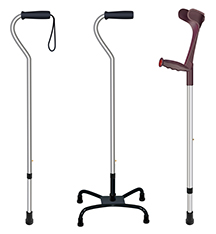
Standard canes have a single base with a rubber tip and a handle.
Quad canes have a wider base with four feet at the end. These canes can provide more stability for people with balance issues.
Forearm canes provide extra forearm support and allow more weight to be distributed from the wrist to the arm.
CRUTCHES
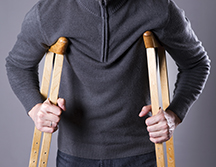
Axillary crutches are standard underam crutches, often used for temporary injuries.
Forearm crutches have a forearm cuff to place the arm through and a hand grip.
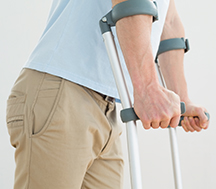
WALKERS
Basic walkers have a three-sided frame that allows people to lift and place the walker ahead of them and then walk up to meet it.
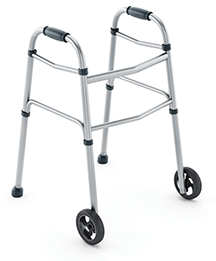
Rollators differ from basic walkers in that they have four wheels at the base of the frame, handlebars with hand brakes, and a seat to allow the user to rest periodically.
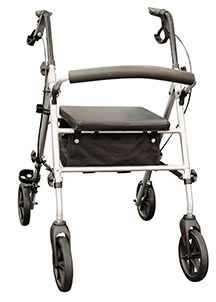
Knee walkers are similar to rollators but allow users to move forward while resting their knee on a padded cushion.
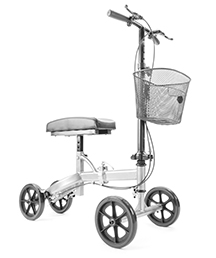
Walker-cane hybrids provide more support than a standard cane and are less bulky than a standard walker. These devices have two legs and can be used with one or both hands.
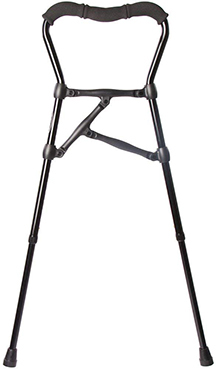
WHEELCHAIRS
Manual wheelchairs allow users to sit and roll themselves or be pushed by someone else. They vary in size, tire type, and construction materials to allow for a range of situations.
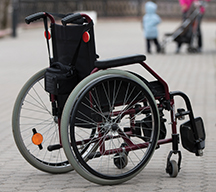
Power wheelchairs are electrically powered allowing users to maneuver using hand controls; however, they do carry a hefty price tag.
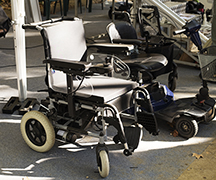
LIFESTYLE MATTERS
Lifestyle is a primary factor in considering whether or not to use one or more mobility devices, and which one(s) to get. Cosi Belloso, a physical therapist who specializes in amputee rehabilition, says that after 17 years of working with amputees, she takes each case on an individual basis, rather than using a standard approach. A favorite example she shares with her students is the story of a bilateral amputee with an above-knee amputation on one side and a below-knee amputation on the other.
“I knew I was going to be able to get him walking independently without any assistive devices; however, he owns a food truck and must do a lot of movement in a tight space,” she says. “He actually said to me he gets around better in his wheelchair while he’s at work, which I was surprised by.”
He already knew what worked for him, so instead of pushing him to walk by himself, Belloso was able to get him into a wheelchair that could maneuver in a tight space. While at home he would walk without assistive devices, but when he was out in the community, he might use forearm crutches, and then at work he would use the wheelchair.
According to Belloso, an above-knee amputee uses approximately 80 percent more energy walking with a prosthesis than a person with anatomical limbs. It’s no wonder that by midday some double amputees are exhausted from just getting around. “Obviously, there’s just a point for some people when they say, ‘You know what, I need a break,’” says Belloso. “So depending on the person, we might recommend a cane to take the stress off a little bit, for instance, or maybe for the trail hiker, it’s using trekking poles.” Such mobility aids and others can help amputees reduce their energy expenditures.
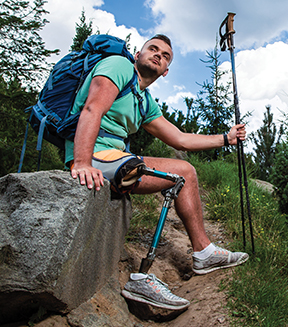
Alternatively, when Belloso sees patients who were active before an amputation but have not been able to walk without a walker, she considers it an opportunity to tap into their potential and get them more active again.
“Unfortunately, many people come to me who’ve never been to a physical therapist who specializes in working with amputees, and they were just given a walker,” says Belloso. “When they come to me, I review their balance, their strength, and their coordination to assess what is preventing them from getting off the walker, and it’s really just individual, different for everyone.”
Belloso stresses that there is no shortcut to improving with a certain mobility device. For instance, it does require extra work to go from something like a walker to a cane because the person is going to need a lot more strength, balance, and coordination to be safe with it. “The end result is higher quality of life,” says Belloso. “It’s a game changer to go from someone who’s become almost homebound to getting back into the community and independent again.
Crutches in Review
There are two types of crutches typically used by amputees—axillary crutches, also called underarm crutches, and forearm crutches, which are sometimes called elbow, Canadian, or Lofstrand crutches. Each has benefits and drawbacks, depending on a person’s individual situation.
FOREARM CRUTCHES
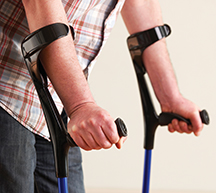
Pros These crutches encourage a more natural posture and are especially good for bilateral amputees to improve their gait pattern. Doctors and physical therapists prefer these crutches for people who will be long-term users.
Cons Since these crutches require a high level of balance, upper-body strength, and more practice to use effectively, they might not be appropriate for some patients, especially those who have recently had surgery.
AXILLARY CRUTCHES
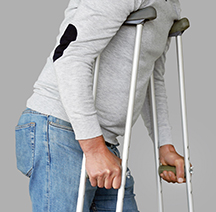
Pros These are a better choice for those who can’t bear weight on a leg, such as amputees who have recently had surgery and haven’t yet received a prosthesis. They hug the body and offer more support, so it’s easier for users to stay non-weight bearing.
Cons These crutches do not encourage correct posture, and they are frequently misused. Incorrect use over the long-term can lead to nerve damage, or crutch palsy, in the armpit area and in the wrists.
PRESCRIPTION FOR SUCCESS
While doctors and prosthetists are able to write prescriptions for and provide mobility devices, Belloso says that the first thing people need to understand is that it’s actually the physical therapist who should be evaluating and recommending the appropriate mobility devices. Belloso says she has seen patients whose prosthetist gave them one device and whose doctor gave them another device, but neither were appropriate. Other times, people simply don’t realize that they have more options because they were told they would never be able to walk again. Belloso’s experience proves that time and again a proper assessment from a physical therapist and time spent doing physical therapy can help people have more options for improved mobility.
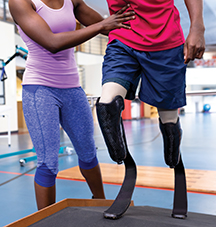
“In some of these cases, the patients are stuck with devices, and their insurance won’t pay for the ones they really need,” she says. “That’s a fairly common problem, and I try my best to intervene before a faulty prescription is made. I would prefer to evaluate the patient to see what their long-term needs are going to be.” Belloso adds that a physical therapist specializing in amputees is preferred to evaluate issues with gait training, but even physical therapists who are not amputee specialists will still be able to give a good recommendation and offer general advice.
Wheelchairs Compared
There are important differences between manual wheelchairs and power wheelchairs, cost notwithstanding. Additionally, within these two larger categories of chairs, there is a great variety of models to choose from. Here are some benefits and drawbacks of each type.
MANUAL WHEELCHAIRS
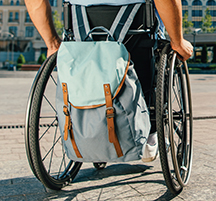
Pros Manual wheelchair users get cardiac and other health benefits from using their body power to propel the chair. This physical activity is important for those who are solely using a wheelchair, since they have a greater risk for heart disease, high blood pressure, and other problems related to a sedentary lifestyle. Additionally, there is a wide range of options to fit users’ needs. Some models are so lightweight that a person can simply fold the chair and put it in a vehicle independently. Manual wheelchairs also require less maintenance since they don’t have electronic parts.
Cons Manual wheelchairs can be difficult for users who have little upper-body strength. Additionally, the repetitive movement needed to propel them can cause overuse injuries in the shoulder. Lastly, navigating hilly areas, rough terrain, and even some types of carpet can be especially challenging for manual chair users.
POWER WHEELCHAIRS
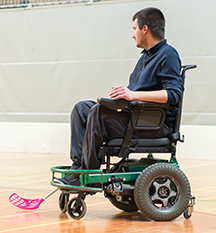
Pros Power chairs offer a chance to gain a measure of freedom and independence simply by using hand controls, which is important for people with severely limited mobility. Users can save energy, move at speeds up to nearly 12 miles per hour, and go up to 55 miles on one charge. Power chairs also have tilt and recline abilities, which can further help people with special needs.
Cons It’s much less common for insurance to pay for power wheelchairs for amputees except in extreme cases, such as for those with quadrilateral amputations. The electronic parts might also break down and require service. Additionally, an electric lift may be needed to to get power wheelchairs in and out of vehicles. Perhaps most importantly, these chairs require little physical activity from the amputee to operate them and may therefore lead to muscle atrophy, bone loss, and reduced endurance.
EVERYDAY MOBILITY AND BEYOND
After 32 surgeries and seven amputations as a result of complications from diabetes and a congenital artery anomoly, Larry Bainum, age 58, is now a double above-knee amputee. He also knows what it’s been like to be a below-knee amputee and an above-knee amputee at the same time. Although he can walk without crutches, Bainum relies on foreshortened prostheses and a wheelchair for everyday mobility.
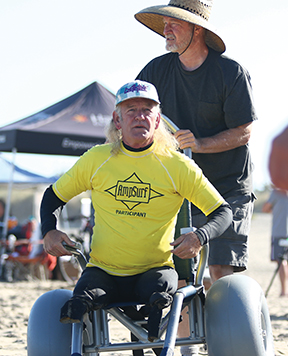
Foreshortened prostheses, also called stubbies, are designed to provide bilateral above-knee amputees a better sense of balance due to a lower center of gravity. “As someone who struggles with circulation and stamina, having energy-saving options helps me do the things I love best,” he says.
What Bainum loves best is helping others. He travels between two homes on opposite coasts to run a nonprofit organization called Fishing Veterans of America, which provides a host of outdoor, thrill-seeking, and fishing adventures to those with limited mobility.
Over the years, Bainum has acquired a range of adaptive equipment, including adaptive controls in his car, adaptive racing go-carts, and adaptive surfboards, that makes his active lifestyle possible for him and those his organization supports. While not recommended for the layperson, Bainum is comfortable with fabrication, so he is able to make his own mobility aids at times, such as foreshortened trekking poles that are made for his height so he can enjoy hiking in nature.
While there are instances when a person might be overwhelmed with the devices they have, that’s more often a result of not having talked to a physical therapist who can make the right recommendation. Once a person knows which devices they need, it can help change the entire picture for their particular situation.
FINDING SOLUTIONS THAT WORK FOR YOU
By Rene Agredano
Spending time outside offers us more than fresh air and sunshine. Studies show that becoming immersed in natural settings can also elevate mood, speed healing, and improve self-esteem. Many mobility devices can take us outside to reap these rewards, but an all-terrain, off-road wheelchair provides more options for your activities.
All-terrain wheelchairs get you closer to nature and heighten the experience of being outside. Specially fabricated with knobby tires, high clearance, and rugged components, they allow users to confidently explore exciting new terrain. Suddenly, barriers like rocky walking paths, snowy sidewalks, and sandy beaches are a thing of the past.
These wheelchairs are built for a variety of needs and budgets. For instance, the Action Trackchair is produced especially for hardcore nature fans who want to reignite their passion for the outdoors. Made by a Minnesota father who wanted to help his newly paralyzed son resume favorite activities like hunting and fishing, the Trackchair is less of a wheelchair and more of a personal mobility ATV. Its top speed is just 3 mph, but having the ability to access favorite hunting, hiking, and fishing spots is worth the trade-off for some wheelchair users. Available in a variety of customizations, including holders for guns and fishing rods, the Humvee of personal mobility solutions has a base price of $11,785.
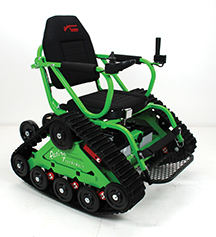
For a back-to-nature experience for people with good upper-body strength, the Mountain Trike manual off-road wheelchair may be a smart choice. This British-made unit starts at about $6,000 USD. The innovative locomotion design allows users to independently propel, steer, and apply the brakes without touching the wheels. Three shock absorbers minimize bounce and hydraulic brakes give excellent control in any kind of weather conditions. You can even motorize it with an optional electric power kit.
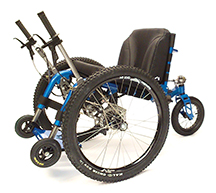
If you’re not quite ready to use a trike, the BOUNDER Plus Power Wheelchair might be a good option. This American-made all-terrain wheelchair has a top speed of 6.5 mph and excellent torque for climbing rough, steep terrain. Mud and snow are no problem either thanks to knobby, low-pressure pneumatic tires and 4.5-inch ground clearance on some configurations.
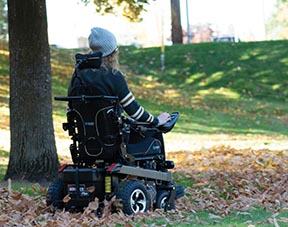
As you may have guessed, all-terrain chairs are not inexpensive. The most rugged, customizable models can cost as much as a pre-owned automobile. Insurance generally doesn’t pay for them, but workarounds exist. Most manufacturers are happy to introduce users to various affordability methods, from company financing to private grants from charitable organizations.



